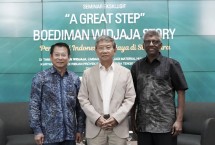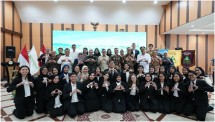Realizing Food Security, Indonesia Begins Self-Sufficiency of Rice Again
By : Abraham Sihombing And Aldo Bella Putra | Saturday, September 16 2017 - 19:00 IWST

Menteri Pertanian Amran Sulaiman dan Presiden Jokowi (Foto (Humas)
INDUSTRY.co.id - Jakarta - Indonesia is now beginning to rebound in rice, fresh chili and onion consumption. In fact, Indonesia is now starting to export onion. This can be achieved thanks to the cooperation between the Ministry of Agriculture and the Indonesian Armed Forces (TNI) in realizing food security.
"Our cooperation with the TNI to realize food security has begun to show good results. It is seen from the absence of rice imports, fresh chili and onion consumption as usually done for price stabilization in the domestic market," said Suwandi, Acting Officer of Public Relations and Information Bureau of the Ministry of Agriculture in Jakarta, Friday (15/09/2017).
Suwandi said that the ability to self-sufficiency and export is proof that Indonesia is able to realize the vision of world food barn in 2045. The next step is self-sufficiency in garlic and sugar consumption in 2019, soybean by 2020, industrial sugar in 2024, and beef in 2026.
"We are already on the right path to our vision when Indonesia is a century old," he said.
Suwandi revealed, as the self-sufficiency, the welfare of farmers also increased as seen in the indicator of poverty in rural areas fell 4.7%. "Initially the poor population in the village in March 2015 was recorded at 17.94 million people and fell to 17.09 million in March 2017," he said.
The next step, the Ministry of Agriculture continues to implement the structural process that ensures the vision of the world food barn 2045 materialized. First, develop agro-based industrialization based on comparative advantage.
"Indonesia must be glorious again for coffee and spices. Integration of upstream-onfarm-downstream activities is built on an economies-wide region so as to generate added value and local income," explained Suwandi.
Second, to strengthen the infrastructure so as to facilitate the flow of distribution from village to city, in the village built roads, irrigation / electricity, electricity, telecommunications, financial institutions, farming markets and others.
Third, industrialization in the countryside will absorb a lot of manpower, so need to increase the capacity of human resources to be professional and productive. Local personnel are trained to use machine tools, workshops, services and others according to competency standards.
Fourth, the limited number of farmers is overcome by mechanization. Kementan provides 80,000-100,000 units of agricultural machine tools annually. With mechanization such as tractor, water pump, rice trans planter, combine harvester and Rice Milling Unit proven to reduce cost up to 40%, time, effort, and decrease shrinkage of crop between 4-8% and improve quality.
"The mechanization technology is what makes the younger generation now interested to plunge into agriculture and rural areas, and the young generation also responded positively to the Ministry of Village-PDT program now," added Suwandi. (Abraham Sihombing)
Read Also
Today's Industry

Rabu, 21 Mei 2025 - 10:09 WIB
Indonesia, Thailand Sign MoU on Health Sector, Focusing on Global Capacity, Collaboration
As a part of President Prabowo Subianto’s official visit to Thailand, both countries signed a Memorandum of Understanding (MoU) on health sector, in an effort to strengthen bilateral cooperation…

Rabu, 21 Mei 2025 - 10:06 WIB
Indonesia, Thailand Deepen Cooperation on Security, Trade, and Regional Stability
resident Prabowo Subianto has reaffirmed Indonesia’s strong commitment to deepening bilateral relations with Thailand during the meeting with Thailand’s Prime Minister Paetongtarn Shinawatra…

Selasa, 20 Mei 2025 - 12:44 WIB
Boediman Widjaja's Technology Ready to be Adopted in Jababeka Industrial Estate (KIJA)
In an exclusive seminar entitled "A Great Step: Boediman Widjaja Story - Going from Indonesia, Thriving in Singapore" held at the President Lounge, Menara Batavia, Boediman Widjaja, Founder…

Jumat, 02 Mei 2025 - 10:46 WIB
Binawan and Government Support Indonesian Nurses in Europe through Scholarships
In the midst of the viral #KaburAjaDulu hashtag as a symbol of the young generation's disappointment with domestic working conditions, Binawan responded with real action: dispatching Indonesian…

Jumat, 28 Maret 2025 - 22:21 WIB
SUNeVision Initiates MEGA IDC Phase Two Development
SUNeVision, the technology arm of Sun Hung Kai Properties (SHKP), today announced the commencement of construction for Phase Two of MEGA IDC in Tseung Kwan O. As Hong Kong's largest data centre…

















News Comment